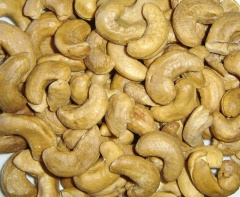Cashew Nuts
| Infobox on Cashew Nuts | |
|---|---|
| Example of Cashew Nuts |  |
| Facts | |
| Origin | This table shows only a selection of the most important countries of origin and should not be thought of as exhaustive.
|
| Stowage factor (in m3/t) |
|
| Humidity / moisture |
|
| Oil content | 45 - 50% |
| Ventilation | Recommended ventilation conditions: air exchange rate at least 10 changes/hour (airing) |
| Risk factors | A high cargo oil content of 45 - 50% encourages the risk of self-heating or rancidity.(see text) |
Cashew Nuts
Description
The cashew nut is the kidney-shaped fruit, complete with shell, of the cashew tree, usually shipped in bags.Cashew kernels, the kernels obtained from the nut, are usually shipped in tins, inside cartons.
Applications
Chiefly eaten raw and used in muesli, salads, desserts, vegetable and meat dishes and in trail mixes. Jam is made from the light yellow, juicy, sharp, fruity-tasting flesh of the cashew apple. In the countries where the cashew apple grows, it is also used in the drinks industry.
Shipment/storage
Cashew kernels are packed in bags, boxes/cartons and/or tins. The tins are either gas-packed or vacuum-packed as a protection against infestation.
Cashew nuts are packaged in, among other things, polysacks (10 - 25 kg).
Use ventilated containers (coffee containers), if the lower limits set for the water content of goods, packaging and flooring and the oil content of the goods are complied with and if protection against solar radiation is ensured (risk of self-heating). Cashew kernels are predominantly shipped in containers.
Raw cashew nuts are subject to damage by moisture and may deteriorate after long storage in an undried state. Nuts may usually be expected to contain some bad kernels. Raw nuts are often imported and re-exported as kernels; for example, nuts are imported into India from East Africa, and then re-exported with kernels of nuts grown in India. It is generally not possible to state definitely whether cashew kernels, when completely processed are of new or old crop or, other than in exceptional circumstances, whether they are from nuts of Indian or African origin. Kernels of one grade should be of an even size, but some degree of tolerance is allowed.
Kernels should be packaged dry; if they are insufficiently dry they may deteriorate, and if in a really damp condition they may become caked, rancid and discoloured, but if packed too dry whole kernels may sustain breakage. Rough handling may damage cartons and tins and cause breakage of kernels. Contact with water may cause discolouration of cartons and rusting of tins, but contents should be unaffected. Kernels are liable to infestation by beetles, moths, larvae, etc., due to improper packaging and not necessarily from external causes. Contents of tins are not expected to suffer loss in weight. Both cashew kernels and the oil contained in cashew nuts are highly inflammable.
In damp weather (rain, snow), the cargo must be protected from moisture, since it may lead to mold, spoilage and self-heating as a result of increased respiratory activity. No hooks should be used with bagged cargo, so as to prevent damage to the bags and loss of volume.
The following features are significant when assessing the damages (loss) in cashew shipments:
1. Crushing – staining of bags – often resulting in C&F Agents tending to reject these as damaged lots.
2. Rain water affect during loading/discharge period at both load/disport in the tropical belt: sudden tropical rain showers are a common occurrence.
3. Defective containers with leaking roof/panels being used for cashew.
4. Excessive condensation in containerised shipment owing to:
- inherent high moisture of raw cashew
- Humidity/temperature in the container as compared to ambient temperature/condition outside.
5. Lack of proper ventilation in normal containers which are usually stuffed to 90% capacity, i.e. block stowage.
In order to ensure safe transport, the bags must be stowed and secured in the means of transport in such a manner that they cannot slip or shift during transport. Attention must also be paid to stowage patterns which may be required as a result of special considerations, such as ventilation measures.
In the event of loading as general cargo, dunnage should be used to protect against damage:
It is very important for the inspector to ascertain the year of harvest: it must be taken into consideration that the nuts may be mixed with nuts from the previous year's harvest. This possibility must not be disregarded when determining whether or not loss has occurred in transit. Nuts from the previous year's harvest have a tendency to beetle infestation and rancidity.
Favorable travel temperature range: 5 - 25°C. Temperatures > 30°C should not prevail for a long period, as such temperatures promote respiration of the cargo and cause self-heating.
Cashew nuts in bags are at risk of moisture penetration and mold formation due to ship/container sweat. The goods may cake, turn rancid and discolor.
Risk factors
Self-heating / Spontaneous combustion
Hydrolytic/enzymatic/oxidative fat cleavage
Odor
Contamination
Mechanical influences
Toxicity / Hazards to health
Shrinkage/Shortage
Insect infestation / Diseases
Note: (Source including Transport Information Service of the GDV)











